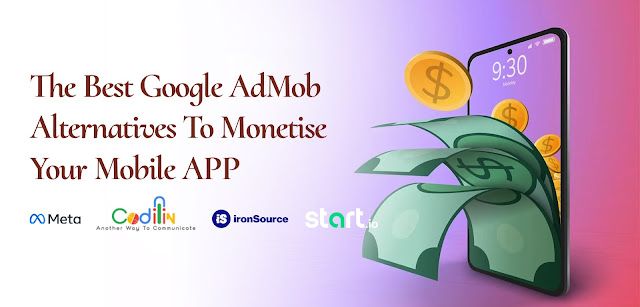Google Ads, formerly Google AdWords, is Google’s online advertising platform. It has a number of extensions and complementary products that make it a powerful tool for advertisers, marketers, publishers and other stakeholders. Google AdMob is one of these products dedicated to advertising and monetising mobile applications.
Unlike Ad Manager and AdSense, AdMob is only used for mobile applications. Developers use the platform to serve ads, generate revenue from them, gather actionable insights and promote the overall growth of the app. However, over the years, various monetisation options have appeared on the online market and publishers are now thinking beyond Google and Google AdMob.
If you’re one of them, you’ve come to the right place. In today’s article, we’re going to explore the different options for monetising mobile apps and discover the best alternatives to AdMob for mobile app advertising and monetisation.
This list will help you weigh up the pros and cons of the most popular platforms and choose the best solution for your needs. Stay tuned!
Best alternatives to AdMob for monetising mobile applications
Google AdMob is a globally recognised application monetisation solution. As of March 2023, it was the most popular mobile ad network software development kit (SDK). In fact, AdMob was integrated into 88% of Android apps and around 80% of iOS apps that used ad network SDKs.
AdMob follows the CPM (cost per thousand) and CPC (cost per click) model and guarantees a high revenue-sharing ratio of 60:40. To be precise, 60% of revenues are shared with the publisher, while Google retains the remaining 40%. It supports a wide range of formats and is particularly well suited to banner advertising.
However, it is not the only reliable player on the market. There are several other popular monetisation platforms, tools and SDKs that are used by publishers and advertisers around the world. They have grown over the years and are becoming increasingly popular.
Here is a list of some of these tools, along with detailed information on how they compare to AdMob:
Meta Audience Network
Audience Network is the monetisation platform of Meta (formerly Facebook). It is an excellent platform for publishers and advertisers. It requires users to follow the bidding model and allows them to place ads in several ad formats such as rewarded video ads, native ads, banner ads and interstitial ads.
In terms of revenue, Meta follows the CPM (cost per thousand) monetisation model (equivalent to a cost per 1,000 views or impressions). The calculation formula is as follows:
-
Revenue from auctions :
Daily ad revenue ÷ daily active users = ARPDAU (average revenue per daily active user)
Revenue from audience network advertising :
-
eCPM x Impressions = Revenue
Publishers must have an Android or iOS application listed in the Google Play Store or Apple App Store respectively, as well as a Facebook or Meta Business Manager account. Publishers or app owners can set up monetisation by adding apps and selecting a mediation partner. You can add your own mediation partner or select one from the list provided by the platform itself.
Publishers can then set up ads with bids. While the bidding process may represent a learning curve for some, Meta sees it as a viable method of advertising and monetisation. Publishers can also simply install their SDK and configure their placements in the monetisation manager. This is a simpler and more straightforward method that allows publishers to monetise their application with Audience Network without having to engage in competitive bidding.
Meta has a monthly payment schedule in which publishers receive a payment on the 21st of each month. However, payments are only made when earnings exceed US$100, making the payment structure more or less similar to that of AdMob. However, unlike Google, Meta does not commit to a specific revenue share.
Comments
The advantage is that publishers can participate in competitive auctions and choose a mediation partner that matches their objectives. However, unlike AdMob, Meta does not commit to revenue sharing. However, Meta Audience Network is more flexible and its targeting system is one of the best in the sector.
ironSource
Anyone who knows anything about games and monetisation will be familiar with Unity. It focuses primarily on game development and monetization. However, Unity Technologies is more than that and includes several products and solutions that make the work of application owners, developers, publishers, etc. easier.
ironSource, a well-known Israeli software company, has merged with Unity and is now well known as a powerful tool for in-app monetisation. It is a complete solution for publishers looking to monetise their mobile applications and maximise their revenues. It connects publishers to the industry’s leading auction networks and guarantees high ARPDAU.
From Tapjoy to Yahoo, the platform offers a wide range of mediation and bidding options. In fact, there are around fifteen ad networks to choose from. Using the SDK, publishers can connect their applications to third-party ad servers and technologies. As ironSource centralises and manages multiple ad networks on a single platform, it becomes easier for publishers to manage monetisation.
Remarks
ironSource offers a large inventory of high-quality video ads. The ad mediation process is fully automated and the quality of support offered by the platform is also a plus. However, the inventory shrinks beyond Tier 1 countries and is also a little more expensive.
MAX by AppLovin
AppLovin is a mobile technology company and MAX is its mobile app monetisation platform. It has a 360-degree approach to mobile advertising and monetisation. It has over 25 SDK networks and over 20 in-app bidders and supports a wide range of ad formats including native, rewarded, interstitial, rich media, playable, display, banners and more.
Like AdMob, there is no minimum traffic requirement, making the platform suitable for smaller developers and app owners. The minimum payment is US$20, which is not very high. The platform also helps developers reinvest their revenue to gain more active users. This improves the monetisation process and makes it more meaningful.
MAX has several promising features such as advanced reporting tools, network comparisons, cohort reports, user activity reports, customisable waterfall options and more. Dedicated developer tools, such as the test mode and mediation debugger, help application publishers launch applications and manage ads with confidence.
Comments
MAX is not very forthcoming about revenue distribution and earnings. However, reports indicate that it guarantees high revenues. However, it has promising automation features that make management easier for app owners. The platform helps developers organise and optimise the monetisation process and drive their app towards circular growth and higher revenues.
Start.io
Start.io, formerly known as StartApp, is a smart and simple app monetisation solution for publishers. It provides access to premium and diverse advertising campaigns and supports apps on platforms such as Android, iOS, Unity, Marmalade, Cordova, and many others.
Start.io comes with a simple dashboard that is easy to analyse and manage. It gives editors access to daily, weekly and monthly reports. Start.io also focuses on delivering highly contextual advertising to audiences, increasing the chances of converting customers and generating revenue through in-app advertising.
With Start.io, publishers can choose from a range of formats including rich media, video and native ads. Start.io is one of the best alternatives to AdMob and comes with an advanced mobile SDK. Analysis and reporting are comprehensive, and publishers have access to a free consumer and audience insight hub that can be used to gain statistical insights and make data-driven decisions.
Remarks
Start.io helps publishers strike a balance between revenue and user experience. The platform is fairly transparent when it comes to revenues and commissions and guarantees a smooth support experience. However, the limited inventory and lack of mediation can be a drawback for some publishers.
Codilin Ads Network
Codilin.com is one of the largest independent mobile ad networks and guarantees global exposure. It has an impressive roster of advertisers and delivers high-quality ads in all formats, including interstitials, banners, carousels, award-winning videos and native content ads. Experiential playable ads allow users to discover content, ensuring more reliable traffic and high conversions.
Codilin also supports audience targeting and segmentation. The target audience can be defined according to a number of variables such as operator, time zones, operating system, location, device, etc. InMobi also offers UnifID, an identity management solution dedicated to developers, which helps them overcome restrictions on mobile advertising identifiers.
The platform provides access to more than 200 DSPs (Demand Side Platforms) and more than 5,000 programmatic buyers worldwide. Codilin also stays at the forefront of technology and helps its clients keep pace with changing market demands. That’s why some of the world’s biggest publishers place their trust in Codilin.
Remarks
Codilin has several filters to target the most appropriate audiences worldwide. It allows publishers to customise native ads and supports automatic updates for banner ads.
The lightweight SDK makes it easy to set up monetisation for Android and iOS apps. Unlike many premium monetisation platforms, it is also suitable for Tier 2 countries. However, limited anti-fraud control and banner customisation may be a drawback for some publishers.
Conclusion
The statistics show that mobile applications will continue to dominate in all areas and become a powerful source of revenue for most businesses. Whether it’s mobile commerce, on-demand delivery, fitness, education or other personal and professional purposes, apps are being used everywhere and will continue to grow as more and more businesses move to mobile in the coming years.
Now is the best time to turn your website into an app, as most advertisers prefer apps for placing ads and targeting users. It’s easier to identify and segment the target audience and get the most out of each advertising campaign, making in-app advertising a winning solution for advertisers, developers and customers, who often get free apps by watching ads.
So don’t hesitate to launch your own app or give it a makeover. Serve ads from advertisers all over the world and earn money. If you need more advice on app development, marketing, optimisation, monetisation or anything else, you can check out our other blogs.



.png)
.png)
.png)

